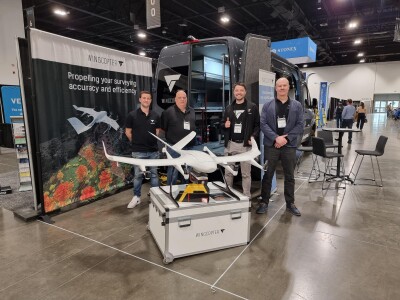ITOCHU Corporation, Wingcopter's partner in Japan, have tested the transport of research blood (*1) using Wingcopter's delivery drone in a research project.  Together with ANA Holdings and the local blood donation center of the Japanese Red Cross, blood products were flown between the cities of Urasoe and Nago in Okinawa Prefecture.
Together with ANA Holdings and the local blood donation center of the Japanese Red Cross, blood products were flown between the cities of Urasoe and Nago in Okinawa Prefecture.
The project (*2) aims to investigate the effectiveness and efficiency of drones in the delivery of blood products, with the long-term goal of relieving the burden on delivery staff and being prepared for disasters, especially in regions where traditional forms of transport are inefficient. The prefecture of Okinawa, with its 48 inhabited islands, is a prime example of such a region. Supplying these islands using conventional delivery methods requires a lot of personnel and time. With drone deliveries, it will be possible to transport only the required amount at the exact moment it is needed. This enables a fast and efficient supply of blood products, even in emergencies and in response to natural disasters. Depending on weather conditions, the 53 km long test route between Urasoe and Nago was covered by the Wingcopter in as little as 32 minutes.
A special transport container was used to keep the blood at a constant temperature of 2 to 6 degrees Celsius during the flight. In addition, experts have also investigated the possible effects of transport by drone on the quality of the blood supplied.
“Okinawa Prefecture is located in the southernmost part of Japan and is known for its high temperatures in the summer. Prior to the Proof of Concept (POC), we conducted multiple basic studies confirming the temperature management capability of the drone’s blood delivery box, which was manufactured and retrofitted by Sugiyamagen Co., Ltd. in Tokyo. In addition, we were able to transport blood in a manner that complies with Japan’s ‘Guidelines for Transporting Medicines by Drones’ ”, elaborates Hiroshi Fujita, MD, PhD, Director of Department of Transfusion Medicine at Tokyo Metropolitan Bokutoh Hospital. “The types of blood transported were red blood cell fluid and whole blood. Both types of blood are likely to be used in disasters and emergencies and require strict temperature control of 2 to 6 degrees Celsius. The guidelines also require measures to deal with vibrations that occur during transportation. In this POC we were able to confirm that the group of blood transported by vehicle and drone was of comparable quality to the blood of the non-flying group (control group). The results of this verification therefore show that drones may be useful as a means of transporting blood appropriately to where it is needed. We hope to see Level 4 (*3) testing of blood transport by drones in the future.”
Armando Koerig Gessinger, Chief Revenue Officer at Wingcopter, comments: “We are pleased to be have worked on this project with ITOCHU, ANA and other partners, and to once again have been able to demonstrate the versatility of the Wingcopter 198. It is important to test as many real-world applications as possible under a wide range of conditions before type certification is granted, so that we can then scale up across Japan together with our partners.”
Kenji Suzuki, Vice President at ANA Holdings Inc., adds; “Based on ANA's technology and experience accumulated through more than 70 years of aircraft operation, ANA performed safe high-speed flights over long distances with the Wingcopter[TD1] . In collaboration with ITOCHU and Wingcopter, ANA will take on the challenge of solving the issues facing the transportation of blood products.”
Masaharu Sato, Deputy General Manager, Aerospace Department at ITOCHU Corporation, adds: “The feasibility study in Okinawa Prefecture brings us another step closer to our goal of offering drone-based services that address the diverse needs and social problems of the Japanese society. That is why we have already conducted POCs with different focuses in Hokkaido and Niigata, among other places, and intend to conduct further ones in the coming months.”
ITOCHU plans to integrate multiple simultaneously operating delivery drones into the conventional ground-based supply network in the future, thus helping to maintain a sustainable medical system, even in the event of labor shortages and emergencies in times of crisis. In addition, the company aims to introduce a commercial drone delivery service, in which the Wingcopter 198 will be used, among other things, to deliver high-priority medical and pharmaceutical products.
In March 2024, Wingcopter, with the support of ITOCHU, had applied for type certification in Japan for the Wingcopter 198 and was the first foreign company to be accepted for the type certification process by the Japan Civil Aviation Bureau (JCAB) of the Ministry of Land, Infrastructure, Transport and Tourism. A successful completion of the process would allow commercial flights beyond visual line of sight (BVLOS) and over inhabited areas.
*1 “Research blood” means blood not suitable for transfusion and used for research and development.
*2 The Testbed POC Support Project FY2024, subsidized by the Okinawa Prefecture Government, aims to support companies with innovative ideas, digital technologies, and services in conducting proof-of-concept (POC) experiments. This initiative seeks to address social challenges and drive innovation in the region.
*3 Level 4 refers to unmanned flights beyond visual line of sight in populated areas.
Source: Wingcopter
















Comments